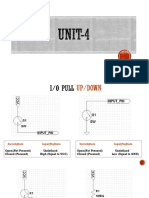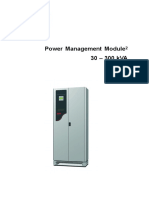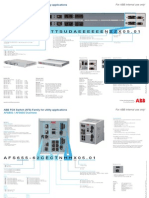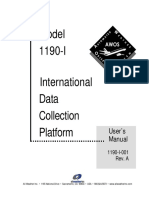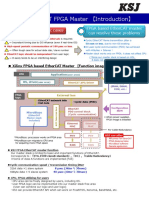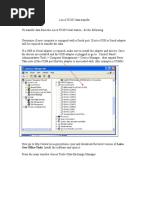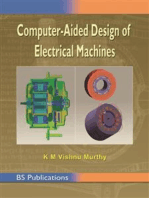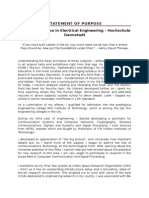E660
E660
Uploaded by
Hillary McgowanCopyright:
Available Formats
E660
E660
Uploaded by
Hillary McgowanOriginal Description:
Copyright
Available Formats
Share this document
Did you find this document useful?
Is this content inappropriate?
Copyright:
Available Formats
E660
E660
Uploaded by
Hillary McgowanCopyright:
Available Formats
<----Fold here
<----Fold here
Trench Austria GmbH
Paschinger Strasse 49, Postfach 13
A-4060 Linz-Leonding/Austria
Phone +43.732.6793-0
Fax
+43.732.6713 41
E-Mail sales@TrenchAustria.at
Technical Data
Electrical Data
EFC 30
EFC 40
Calculation Algorithm
Controller
CPU
memory
display
keyboard
power supply
detuning of the ASC
current injection
Trench Brasil LTDA
Via Expressa de Contagem, 2685
CEP 32370-485
Cpmtagem, MG - Brasil
Phone 55. 31. 391-5959
Fax 55. 31. 391-1828
trenchbrasil@ca.trenchgroup.com
32 bit Transputer (RISC Processor) with floating point unit
1 MB RAM
8 MB RAM
double supertwist LCD 640x200 pixels with background lighting
film type
110 ... 230 V AC, 50 Hz, 50W
optional: 24, 48, 60 V DC
Analogue inputs
input ranges are adjustable by software
V12
100 V AC reference voltage
V0
3 mV ... 230 V AC
3 mV ... 110 V AC
Ieci
1 A, current injections
ASC position [A]
linear potentiometer 200 Ohm ... 2 kOhm or
current source built into the ASC 0 ... 20 mA
Digital inputs
4 potential free contacts, 16 inputs 24 V 250 V AC or DC
24 V DC/60 mA
2 impulse inputs 0,1 s ... 2 s,
24 ... 250 V AC or DC
Digital outputs
7
16
freely assignable contacts
250 V AC, 4 A, 1000 VA max resp. 250 V DC, 1 A, 100 W max
Analogue outputs
software programmable characteristics, potential free
V0
1 ... 20 mA selectable range, linear, bent or logarithmic
ASC position
1 ... 20 mA selectable range, linear
All in- and outputs are designed according to
VDE 110 part 1
overvoltage class III, contamination level II, insulation class IIIa
VDE 0435 part 303,
50Hz test voltage: 2000 V rms., 1 min
class III
impulse voltage test (1.2/50 s): 5 kV
HF interference test: 2.5 kV
VDE 0160 W2
overvoltage withstand capability
VDE 0843
ESD level 3: test voltage 8 kV, burst test (power supply): 4 kV,
burst test (signal input lines): 2 kV
Trench Limited
Coil Product Division
71 Maybrook Drive, Scarborough
Ontario, Canada M1V 4B6
Phone (416) 298-8108
Fax
(416) 298-2209
E-Mail sales@ca.trenchgroup.com
Trench Limited
Instrument Transformer Division
390 Midwest Road, Scarborough
Ontario, Canada M1P 3B5
Phone (416) 751-8570
Fax
(416) 751-6952
E-Mail sales@ca.trenchgroup.com
Trench France S.A.
16, rue du Gnral Cassagnou
B.P. 70
F - 68302 St-Louis Cedex/France
Phone +33.3.89 70 23 23
Fax
+33.3.89 67 26 63
E-Mail sales@trench-france.com
Trench Germany GmbH
Nrnberger Strasse 199
96050 Bamberg/Germany
Phone +49.951.1803-0
Fax
+49.951.1803-224
E-Mail sales@trench.de
www.trenchgroup.com
Trench Switzerland AG
Lehenmattstrasse 353
CH - 4028 Basel/Switzerland
Phone +41.61.315 51 11
Fax
+41.61.315 59 00
E-Mail sales@trench.ch
Mechanical Data
Climatic conditions
operation temperature
storage temperature
transport temperature
humidity
Dimensions
width/height/depth
max. depth
(incl. protective case):
Weight
Subject to change without notice
04.2000
E 660
-5 C to +40 C
-25 C to +55 C
-25 C to +70 C
class G according to DIN 40040
483/132.5/252 mm
483/266/300 mm
350 mm
350 mm
approx. 8.2kg
approx. 13.5 kg
5
Earth-Fault Compensation Controller
EFC30 / EFC40
<----Fo d here
Control Algorithms
In high impedance grounded
power distribution networks
the neutral point of the network is connected to earth by
means of an inductance
coil which is adjusted
continuously or stepwise. If
the resonance circuit formed
by the adjustable inductance
coil and the earth capacitance of the network is tuned
to or close to resonance, the
fault current is greatly reduced
in case of a line-to-earth fault
(earth fault). In most cases the
arc caused by the fault current is
extinguished with no need to
switch off the faulty part of the
network.
Minimal Coil Movement
(EFC30)
As the Arc Suppression Coil
(ASC) and the earth capacitance form a resonance circuit,
the neutral-to-ground voltage
of the network depends on the
value of the inductance of
the ASC and reaches a maximum when the ASC is tuned
to resonance. This dependence
of the neutral-to-ground voltage
is utilized by the EFC30/EFC40
Earth-Fault Compensation
Controller for automatic tuning
of on-load adjustable ASCs.
This method relies on a sufficient
asymmetry of the network.
Whether this method is applied
or not, is determined by setting a
threshold value of neutral to
ground voltage.
In case of a tuning operation
the ASC is adjusted by a small
amount. Using the known
coil-position as well as the
neutral-to-ground voltage
measured before and after the
adjustment operation, the
controller computes the
detuning value v, the asymmetry
value k and the damping
value d, which determine the
resonance curve of the
neutral-to-ground voltage.
Taking into consideration the
desired, software-adjustable
under- or overcompensation, the
controller calculates the
necessary position and directly
adjusts the ASC to the calculated
value.
Determining the
Resonance Peak by
Going beyond It (EFC30)
This method may be used if
the asymmetry of the network
is small, which results in very
Configuration of the EFC30 and the EFC 40
low neutral-to-ground
voltages. In this case, network
reactions may cause fluctuations
of the neutral-to-ground voltage.
Therefore it is not possible to
reliably compute the parameters
of the network by means of
slight detuning of the ASC.
The controller therefore adjusts
the ASC over a wider range,
which must include the resonance
peak. It stores the measured
values and calculates a mediated
resonance curve. Taking into
consideration the desired underor overcompensation, it computes
the necessary position and
adjusts the ASC to that value.
EFC40 Algorithm
In case of very symmetric networks there is no reliable
resonance-curve available
for tuning. By means of a short
(seconds) variation of the
neutral-to-ground voltage using
current injection the equivalent
impedance of the resonance
circuit can be computed. Without prior movement, the ASC is
now positioned directly to the
desired compensation.
Hardware
Hardware Options
Software
Microprocessor-controller
19-rack-mounted
(EFC30 3HU, EFC40 6HU)
Serial Interface
(3 x RS232)
User-friendly, menu driven
operation
Terminal Strip (AKL)
"Help"-texts for all
essential menu options
Simple operation by means
of a film-type keyboard
and a 640x200 pixel LCD
graphic display located on the
front panel (fig. 1)
High EMC by means of:
The measured signals are
shown digitally as well as
in analogue form, both as
a bar diagram and as a
resonance curve.
The operation status is
displayed by message
text. Fault conditions (e.g.
no coil movement) are
signalled by short text
describing the fault
condition.
Protective housing
Wall-Mounting Option
Alternative Power Supply
Voltages
galvanic separation
and filtering of inputs and
outputs
AUTOMATIC (FW)
The factory-set
parameters can be
changed by the
user
96-03-20
16:48:11
The wave shape and its
spectral analysis (FFT) of
the neutral-to-ground
voltage can be displayed.
U = 2.197 %
0.254 kV
U% (D:2)tuned
I = 58.01 %
58.01 A
fully chromised unit
high creepage
distances on printed
circuit cards and plugs
software- and
hardware-monitored
program operation
Fig. 1
Typical display
(resonance curve)
Fix = 0.0 %
zero sequence voltage
Application
<----Fo d here
Ires =
% Ik =
k=
Recording of various network
conditions (e.g. transient
earth-faults) and controller
operation modes for statistical
evaluations.
55.6 %
5.0 %
0.10 %
v=
0.046
d=
1.8 %
EW = 0
Continuous recording of
the measured signals with
the possibility of
displaying or downloading to a PC or SCADA
system via the optional
serial interface.
coil-position
parameters are stored
in non-volatile memory
Highly flexible due to adjustment by software of the
analogue inputs and outputs;
allows user selection of digital
inputs and outputs for control,
monitor etc.
Remote parameter changes
with a PC connected via a
modem to the optional
serial interface.
3
Password-protected
parameters.
Software Options
(EFC30-mode)
Control of an additional
fixed coil (automatic
switching on/off of the
fixed coil)
Control of a resistor, to
increase the ohmic
component of the fault
current.
Adjusting the ASC to a
pre-defined value when
the ASC is switched-off.
Several controllers within
the same network system
(up to four controllers may
work without disturbing
each other, even if they
are not connected to each
other by means of
SCADA.)
Automatic switching of a
damping resistor during
the search operation if U
exceeds Umax
Time-synchronization by
means of an impulse
input line
Special functions for
extremely low/high
neutral-to-ground
voltages
Interconnection to SCADA
(SPAbus, IEC 870-5-103/VDEW 6)
EFC40
The EFC40 offers the following
features:
EFC30 mode
compensation even in
case of very symmetric
networks by controlling a
device which provides
variation of the neutral-toground voltage (e.g.
current injection)
computing the detuning
without coil movement
controlling of stepadjustable ASCs
controlling of high speed
continuously adjustable
coils
easy to upgrade to a
complete earth fault
detection system
<----Fo d here
Control Algorithms
In high impedance grounded
power distribution networks
the neutral point of the network is connected to earth by
means of an inductance
coil which is adjusted
continuously or stepwise. If
the resonance circuit formed
by the adjustable inductance
coil and the earth capacitance of the network is tuned
to or close to resonance, the
fault current is greatly reduced
in case of a line-to-earth fault
(earth fault). In most cases the
arc caused by the fault current is
extinguished with no need to
switch off the faulty part of the
network.
Minimal Coil Movement
(EFC30)
As the Arc Suppression Coil
(ASC) and the earth capacitance form a resonance circuit,
the neutral-to-ground voltage
of the network depends on the
value of the inductance of
the ASC and reaches a maximum when the ASC is tuned
to resonance. This dependence
of the neutral-to-ground voltage
is utilized by the EFC30/EFC40
Earth-Fault Compensation
Controller for automatic tuning
of on-load adjustable ASCs.
This method relies on a sufficient
asymmetry of the network.
Whether this method is applied
or not, is determined by setting a
threshold value of neutral to
ground voltage.
In case of a tuning operation
the ASC is adjusted by a small
amount. Using the known
coil-position as well as the
neutral-to-ground voltage
measured before and after the
adjustment operation, the
controller computes the
detuning value v, the asymmetry
value k and the damping
value d, which determine the
resonance curve of the
neutral-to-ground voltage.
Taking into consideration the
desired, software-adjustable
under- or overcompensation, the
controller calculates the
necessary position and directly
adjusts the ASC to the calculated
value.
Determining the
Resonance Peak by
Going beyond It (EFC30)
This method may be used if
the asymmetry of the network
is small, which results in very
Configuration of the EFC30 and the EFC 40
low neutral-to-ground
voltages. In this case, network
reactions may cause fluctuations
of the neutral-to-ground voltage.
Therefore it is not possible to
reliably compute the parameters
of the network by means of
slight detuning of the ASC.
The controller therefore adjusts
the ASC over a wider range,
which must include the resonance
peak. It stores the measured
values and calculates a mediated
resonance curve. Taking into
consideration the desired underor overcompensation, it computes
the necessary position and
adjusts the ASC to that value.
EFC40 Algorithm
In case of very symmetric networks there is no reliable
resonance-curve available
for tuning. By means of a short
(seconds) variation of the
neutral-to-ground voltage using
current injection the equivalent
impedance of the resonance
circuit can be computed. Without prior movement, the ASC is
now positioned directly to the
desired compensation.
Hardware
Hardware Options
Software
Microprocessor-controller
19-rack-mounted
(EFC30 3HU, EFC40 6HU)
Serial Interface
(3 x RS232)
User-friendly, menu driven
operation
Terminal Strip (AKL)
"Help"-texts for all
essential menu options
Simple operation by means
of a film-type keyboard
and a 640x200 pixel LCD
graphic display located on the
front panel (fig. 1)
High EMC by means of:
The measured signals are
shown digitally as well as
in analogue form, both as
a bar diagram and as a
resonance curve.
The operation status is
displayed by message
text. Fault conditions (e.g.
no coil movement) are
signalled by short text
describing the fault
condition.
Protective housing
Wall-Mounting Option
Alternative Power Supply
Voltages
galvanic separation
and filtering of inputs and
outputs
AUTOMATIC (FW)
The factory-set
parameters can be
changed by the
user
96-03-20
16:48:11
The wave shape and its
spectral analysis (FFT) of
the neutral-to-ground
voltage can be displayed.
U = 2.197 %
0.254 kV
U% (D:2)tuned
I = 58.01 %
58.01 A
fully chromised unit
high creepage
distances on printed
circuit cards and plugs
software- and
hardware-monitored
program operation
Fig. 1
Typical display
(resonance curve)
Fix = 0.0 %
zero sequence voltage
Application
<----Fo d here
Ires =
% Ik =
k=
Recording of various network
conditions (e.g. transient
earth-faults) and controller
operation modes for statistical
evaluations.
55.6 %
5.0 %
0.10 %
v=
0.046
d=
1.8 %
EW = 0
Continuous recording of
the measured signals with
the possibility of
displaying or downloading to a PC or SCADA
system via the optional
serial interface.
coil-position
parameters are stored
in non-volatile memory
Highly flexible due to adjustment by software of the
analogue inputs and outputs;
allows user selection of digital
inputs and outputs for control,
monitor etc.
Remote parameter changes
with a PC connected via a
modem to the optional
serial interface.
3
Password-protected
parameters.
Software Options
(EFC30-mode)
Control of an additional
fixed coil (automatic
switching on/off of the
fixed coil)
Control of a resistor, to
increase the ohmic
component of the fault
current.
Adjusting the ASC to a
pre-defined value when
the ASC is switched-off.
Several controllers within
the same network system
(up to four controllers may
work without disturbing
each other, even if they
are not connected to each
other by means of
SCADA.)
Automatic switching of a
damping resistor during
the search operation if U
exceeds Umax
Time-synchronization by
means of an impulse
input line
Special functions for
extremely low/high
neutral-to-ground
voltages
Interconnection to SCADA
(SPAbus, IEC 870-5-103/VDEW 6)
EFC40
The EFC40 offers the following
features:
EFC30 mode
compensation even in
case of very symmetric
networks by controlling a
device which provides
variation of the neutral-toground voltage (e.g.
current injection)
computing the detuning
without coil movement
controlling of stepadjustable ASCs
controlling of high speed
continuously adjustable
coils
easy to upgrade to a
complete earth fault
detection system
<----Fo d here
Control Algorithms
In high impedance grounded
power distribution networks
the neutral point of the network is connected to earth by
means of an inductance
coil which is adjusted
continuously or stepwise. If
the resonance circuit formed
by the adjustable inductance
coil and the earth capacitance of the network is tuned
to or close to resonance, the
fault current is greatly reduced
in case of a line-to-earth fault
(earth fault). In most cases the
arc caused by the fault current is
extinguished with no need to
switch off the faulty part of the
network.
Minimal Coil Movement
(EFC30)
As the Arc Suppression Coil
(ASC) and the earth capacitance form a resonance circuit,
the neutral-to-ground voltage
of the network depends on the
value of the inductance of
the ASC and reaches a maximum when the ASC is tuned
to resonance. This dependence
of the neutral-to-ground voltage
is utilized by the EFC30/EFC40
Earth-Fault Compensation
Controller for automatic tuning
of on-load adjustable ASCs.
This method relies on a sufficient
asymmetry of the network.
Whether this method is applied
or not, is determined by setting a
threshold value of neutral to
ground voltage.
In case of a tuning operation
the ASC is adjusted by a small
amount. Using the known
coil-position as well as the
neutral-to-ground voltage
measured before and after the
adjustment operation, the
controller computes the
detuning value v, the asymmetry
value k and the damping
value d, which determine the
resonance curve of the
neutral-to-ground voltage.
Taking into consideration the
desired, software-adjustable
under- or overcompensation, the
controller calculates the
necessary position and directly
adjusts the ASC to the calculated
value.
Determining the
Resonance Peak by
Going beyond It (EFC30)
This method may be used if
the asymmetry of the network
is small, which results in very
Configuration of the EFC30 and the EFC 40
low neutral-to-ground
voltages. In this case, network
reactions may cause fluctuations
of the neutral-to-ground voltage.
Therefore it is not possible to
reliably compute the parameters
of the network by means of
slight detuning of the ASC.
The controller therefore adjusts
the ASC over a wider range,
which must include the resonance
peak. It stores the measured
values and calculates a mediated
resonance curve. Taking into
consideration the desired underor overcompensation, it computes
the necessary position and
adjusts the ASC to that value.
EFC40 Algorithm
In case of very symmetric networks there is no reliable
resonance-curve available
for tuning. By means of a short
(seconds) variation of the
neutral-to-ground voltage using
current injection the equivalent
impedance of the resonance
circuit can be computed. Without prior movement, the ASC is
now positioned directly to the
desired compensation.
Hardware
Hardware Options
Software
Microprocessor-controller
19-rack-mounted
(EFC30 3HU, EFC40 6HU)
Serial Interface
(3 x RS232)
User-friendly, menu driven
operation
Terminal Strip (AKL)
"Help"-texts for all
essential menu options
Simple operation by means
of a film-type keyboard
and a 640x200 pixel LCD
graphic display located on the
front panel (fig. 1)
High EMC by means of:
The measured signals are
shown digitally as well as
in analogue form, both as
a bar diagram and as a
resonance curve.
The operation status is
displayed by message
text. Fault conditions (e.g.
no coil movement) are
signalled by short text
describing the fault
condition.
Protective housing
Wall-Mounting Option
Alternative Power Supply
Voltages
galvanic separation
and filtering of inputs and
outputs
AUTOMATIC (FW)
The factory-set
parameters can be
changed by the
user
96-03-20
16:48:11
The wave shape and its
spectral analysis (FFT) of
the neutral-to-ground
voltage can be displayed.
U = 2.197 %
0.254 kV
U% (D:2)tuned
I = 58.01 %
58.01 A
fully chromised unit
high creepage
distances on printed
circuit cards and plugs
software- and
hardware-monitored
program operation
Fig. 1
Typical display
(resonance curve)
Fix = 0.0 %
zero sequence voltage
Application
<----Fo d here
Ires =
% Ik =
k=
Recording of various network
conditions (e.g. transient
earth-faults) and controller
operation modes for statistical
evaluations.
55.6 %
5.0 %
0.10 %
v=
0.046
d=
1.8 %
EW = 0
Continuous recording of
the measured signals with
the possibility of
displaying or downloading to a PC or SCADA
system via the optional
serial interface.
coil-position
parameters are stored
in non-volatile memory
Highly flexible due to adjustment by software of the
analogue inputs and outputs;
allows user selection of digital
inputs and outputs for control,
monitor etc.
Remote parameter changes
with a PC connected via a
modem to the optional
serial interface.
3
Password-protected
parameters.
Software Options
(EFC30-mode)
Control of an additional
fixed coil (automatic
switching on/off of the
fixed coil)
Control of a resistor, to
increase the ohmic
component of the fault
current.
Adjusting the ASC to a
pre-defined value when
the ASC is switched-off.
Several controllers within
the same network system
(up to four controllers may
work without disturbing
each other, even if they
are not connected to each
other by means of
SCADA.)
Automatic switching of a
damping resistor during
the search operation if U
exceeds Umax
Time-synchronization by
means of an impulse
input line
Special functions for
extremely low/high
neutral-to-ground
voltages
Interconnection to SCADA
(SPAbus, IEC 870-5-103/VDEW 6)
EFC40
The EFC40 offers the following
features:
EFC30 mode
compensation even in
case of very symmetric
networks by controlling a
device which provides
variation of the neutral-toground voltage (e.g.
current injection)
computing the detuning
without coil movement
controlling of stepadjustable ASCs
controlling of high speed
continuously adjustable
coils
easy to upgrade to a
complete earth fault
detection system
<----Fold here
<----Fold here
Trench Austria GmbH
Paschinger Strasse 49, Postfach 13
A-4060 Linz-Leonding/Austria
Phone +43.732.6793-0
Fax
+43.732.6713 41
E-Mail sales@TrenchAustria.at
Technical Data
Electrical Data
EFC 30
EFC 40
Calculation Algorithm
Controller
CPU
memory
display
keyboard
power supply
detuning of the ASC
current injection
Trench Brasil LTDA
Via Expressa de Contagem, 2685
CEP 32370-485
Cpmtagem, MG - Brasil
Phone 55. 31. 391-5959
Fax 55. 31. 391-1828
trenchbrasil@ca.trenchgroup.com
32 bit Transputer (RISC Processor) with floating point unit
1 MB RAM
8 MB RAM
double supertwist LCD 640x200 pixels with background lighting
film type
110 ... 230 V AC, 50 Hz, 50W
optional: 24, 48, 60 V DC
Analogue inputs
input ranges are adjustable by software
V12
100 V AC reference voltage
V0
3 mV ... 230 V AC
3 mV ... 110 V AC
Ieci
1 A, current injections
ASC position [A]
linear potentiometer 200 Ohm ... 2 kOhm or
current source built into the ASC 0 ... 20 mA
Digital inputs
4 potential free contacts, 16 inputs 24 V 250 V AC or DC
24 V DC/60 mA
2 impulse inputs 0,1 s ... 2 s,
24 ... 250 V AC or DC
Digital outputs
7
16
freely assignable contacts
250 V AC, 4 A, 1000 VA max resp. 250 V DC, 1 A, 100 W max
Analogue outputs
software programmable characteristics, potential free
V0
1 ... 20 mA selectable range, linear, bent or logarithmic
ASC position
1 ... 20 mA selectable range, linear
All in- and outputs are designed according to
VDE 110 part 1
overvoltage class III, contamination level II, insulation class IIIa
VDE 0435 part 303,
50Hz test voltage: 2000 V rms., 1 min
class III
impulse voltage test (1.2/50 s): 5 kV
HF interference test: 2.5 kV
VDE 0160 W2
overvoltage withstand capability
VDE 0843
ESD level 3: test voltage 8 kV, burst test (power supply): 4 kV,
burst test (signal input lines): 2 kV
Trench Limited
Coil Product Division
71 Maybrook Drive, Scarborough
Ontario, Canada M1V 4B6
Phone (416) 298-8108
Fax
(416) 298-2209
E-Mail sales@ca.trenchgroup.com
Trench Limited
Instrument Transformer Division
390 Midwest Road, Scarborough
Ontario, Canada M1P 3B5
Phone (416) 751-8570
Fax
(416) 751-6952
E-Mail sales@ca.trenchgroup.com
Trench France S.A.
16, rue du Gnral Cassagnou
B.P. 70
F - 68302 St-Louis Cedex/France
Phone +33.3.89 70 23 23
Fax
+33.3.89 67 26 63
E-Mail sales@trench-france.com
Trench Germany GmbH
Nrnberger Strasse 199
96050 Bamberg/Germany
Phone +49.951.1803-0
Fax
+49.951.1803-224
E-Mail sales@trench.de
www.trenchgroup.com
Trench Switzerland AG
Lehenmattstrasse 353
CH - 4028 Basel/Switzerland
Phone +41.61.315 51 11
Fax
+41.61.315 59 00
E-Mail sales@trench.ch
Mechanical Data
Climatic conditions
operation temperature
storage temperature
transport temperature
humidity
Dimensions
width/height/depth
max. depth
(incl. protective case):
Weight
Subject to change without notice
04.2000
E 660
-5 C to +40 C
-25 C to +55 C
-25 C to +70 C
class G according to DIN 40040
483/132.5/252 mm
483/266/300 mm
350 mm
350 mm
approx. 8.2kg
approx. 13.5 kg
5
Earth-Fault Compensation Controller
EFC30 / EFC40
<----Fold here
<----Fold here
Trench Austria GmbH
Paschinger Strasse 49, Postfach 13
A-4060 Linz-Leonding/Austria
Phone +43.732.6793-0
Fax
+43.732.6713 41
E-Mail sales@TrenchAustria.at
Technical Data
Electrical Data
EFC 30
EFC 40
Calculation Algorithm
Controller
CPU
memory
display
keyboard
power supply
detuning of the ASC
current injection
Trench Brasil LTDA
Via Expressa de Contagem, 2685
CEP 32370-485
Cpmtagem, MG - Brasil
Phone 55. 31. 391-5959
Fax 55. 31. 391-1828
trenchbrasil@ca.trenchgroup.com
32 bit Transputer (RISC Processor) with floating point unit
1 MB RAM
8 MB RAM
double supertwist LCD 640x200 pixels with background lighting
film type
110 ... 230 V AC, 50 Hz, 50W
optional: 24, 48, 60 V DC
Analogue inputs
input ranges are adjustable by software
V12
100 V AC reference voltage
V0
3 mV ... 230 V AC
3 mV ... 110 V AC
Ieci
1 A, current injections
ASC position [A]
linear potentiometer 200 Ohm ... 2 kOhm or
current source built into the ASC 0 ... 20 mA
Digital inputs
4 potential free contacts, 16 inputs 24 V 250 V AC or DC
24 V DC/60 mA
2 impulse inputs 0,1 s ... 2 s,
24 ... 250 V AC or DC
Digital outputs
7
16
freely assignable contacts
250 V AC, 4 A, 1000 VA max resp. 250 V DC, 1 A, 100 W max
Analogue outputs
software programmable characteristics, potential free
V0
1 ... 20 mA selectable range, linear, bent or logarithmic
ASC position
1 ... 20 mA selectable range, linear
All in- and outputs are designed according to
VDE 110 part 1
overvoltage class III, contamination level II, insulation class IIIa
VDE 0435 part 303,
50Hz test voltage: 2000 V rms., 1 min
class III
impulse voltage test (1.2/50 s): 5 kV
HF interference test: 2.5 kV
VDE 0160 W2
overvoltage withstand capability
VDE 0843
ESD level 3: test voltage 8 kV, burst test (power supply): 4 kV,
burst test (signal input lines): 2 kV
Trench Limited
Coil Product Division
71 Maybrook Drive, Scarborough
Ontario, Canada M1V 4B6
Phone (416) 298-8108
Fax
(416) 298-2209
E-Mail sales@ca.trenchgroup.com
Trench Limited
Instrument Transformer Division
390 Midwest Road, Scarborough
Ontario, Canada M1P 3B5
Phone (416) 751-8570
Fax
(416) 751-6952
E-Mail sales@ca.trenchgroup.com
Trench France S.A.
16, rue du Gnral Cassagnou
B.P. 70
F - 68302 St-Louis Cedex/France
Phone +33.3.89 70 23 23
Fax
+33.3.89 67 26 63
E-Mail sales@trench-france.com
Trench Germany GmbH
Nrnberger Strasse 199
96050 Bamberg/Germany
Phone +49.951.1803-0
Fax
+49.951.1803-224
E-Mail sales@trench.de
www.trenchgroup.com
Trench Switzerland AG
Lehenmattstrasse 353
CH - 4028 Basel/Switzerland
Phone +41.61.315 51 11
Fax
+41.61.315 59 00
E-Mail sales@trench.ch
Mechanical Data
Climatic conditions
operation temperature
storage temperature
transport temperature
humidity
Dimensions
width/height/depth
max. depth
(incl. protective case):
Weight
Subject to change without notice
04.2000
E 660
-5 C to +40 C
-25 C to +55 C
-25 C to +70 C
class G according to DIN 40040
483/132.5/252 mm
483/266/300 mm
350 mm
350 mm
approx. 8.2kg
approx. 13.5 kg
5
Earth-Fault Compensation Controller
EFC30 / EFC40
You might also like
- Cooper Edison Idea iXP-420 Differential RelayDocument16 pagesCooper Edison Idea iXP-420 Differential Relay6bngdz4xhkNo ratings yet
- Answer - Questions On Regulation On Professional ConductDocument23 pagesAnswer - Questions On Regulation On Professional Conducthisterling100% (2)
- Rphdoc e Z 04Document75 pagesRphdoc e Z 04ThiagoPinheiroNo ratings yet
- Warnings & Errors Codes PDFDocument158 pagesWarnings & Errors Codes PDFJherly R IllescaNo ratings yet
- External - HPT604 Fuel Sensor Installation and Calibration Instructions V2 2 300721Document7 pagesExternal - HPT604 Fuel Sensor Installation and Calibration Instructions V2 2 300721GabrielNo ratings yet
- Service Manual: /mitsubishiDocument96 pagesService Manual: /mitsubishiSergio L. SuligoyNo ratings yet
- STS365TDocument8 pagesSTS365TĐỗ DũngNo ratings yet
- Gateway/Interface Converter Version 1.9Document24 pagesGateway/Interface Converter Version 1.9Isaac SidibeNo ratings yet
- AP000100 EngDocument9 pagesAP000100 EngLucas WrightNo ratings yet
- User Manual: Earthfault Compensation Controller EFC50Document122 pagesUser Manual: Earthfault Compensation Controller EFC50Ichim NasuiNo ratings yet
- Getting Started GuideDocument23 pagesGetting Started GuideTOPOTRONIKNo ratings yet
- EATON APR48 - DC Power SolutionsDocument26 pagesEATON APR48 - DC Power SolutionsTri Ari NugrohoNo ratings yet
- Design of Isolated Interleaved Boost DC-DC Converter Based On Sic Power Devices For Microinverter ApplicationsDocument6 pagesDesign of Isolated Interleaved Boost DC-DC Converter Based On Sic Power Devices For Microinverter Applicationsgrasia77No ratings yet
- Netview IEC61850 ManualDocument7 pagesNetview IEC61850 Manualicad_09No ratings yet
- ABB Switzerland LTD: Utility Automation / MCD 80.PPT / Doser P 1Document15 pagesABB Switzerland LTD: Utility Automation / MCD 80.PPT / Doser P 1chandrakant patelNo ratings yet
- OPL-1T - Product - Description - R3-I - (MVJ Sun)Document82 pagesOPL-1T - Product - Description - R3-I - (MVJ Sun)Kishore KumarNo ratings yet
- RTU511Document9 pagesRTU511Sambit MohapatraNo ratings yet
- VisiLogic CommunicationDocument146 pagesVisiLogic CommunicationEduardo Madrigal JimenezNo ratings yet
- OPC-2 Installation and Commissioning (MVJ Sun Web Version 4.3) R0-I (Encrypted)Document56 pagesOPC-2 Installation and Commissioning (MVJ Sun Web Version 4.3) R0-I (Encrypted)Андрюха ЛуценкоNo ratings yet
- Ready-To-Connect: Solutions For Smart Transformer SubstationsDocument6 pagesReady-To-Connect: Solutions For Smart Transformer SubstationsMallampati RamakrishnaNo ratings yet
- msp430 Unit4Document118 pagesmsp430 Unit4hemalathaNo ratings yet
- 08 PL Cfs2 Ch8 Planning Guide p3 4 1xxDocument48 pages08 PL Cfs2 Ch8 Planning Guide p3 4 1xxZeph666No ratings yet
- C3FT30 EngDocument373 pagesC3FT30 EngALBNo ratings yet
- EdgeProbe Advanced Users Manual 1 2Document79 pagesEdgeProbe Advanced Users Manual 1 2jeri_aries11No ratings yet
- Protocol and ION TechnologyDocument10 pagesProtocol and ION TechnologyLázaroNo ratings yet
- Technical Guidance Notes: Ethernet Interface Ruggedcom RMC30Document29 pagesTechnical Guidance Notes: Ethernet Interface Ruggedcom RMC30Jose Jesus MamaniNo ratings yet
- Pac f100Document90 pagesPac f100Emir GündüzNo ratings yet
- Manual Filtros Activos New Accusine Manual - 90-10009 - RevADocument55 pagesManual Filtros Activos New Accusine Manual - 90-10009 - RevAivan quirogaNo ratings yet
- Implementation of A Digital Signal Processor-Controlled Shunt Active FilterDocument10 pagesImplementation of A Digital Signal Processor-Controlled Shunt Active FilterJuan Camilo DelgadoNo ratings yet
- APLAB LTD. Rhino UPSDocument2 pagesAPLAB LTD. Rhino UPSTanmoy AcharyaNo ratings yet
- E560 Cmu05 DSDocument4 pagesE560 Cmu05 DSJoao Santos100% (1)
- Deye 16KW Hybrid InverterDocument2 pagesDeye 16KW Hybrid Inverterkresennn100% (1)
- Operacion PMMDocument28 pagesOperacion PMMalio0oNo ratings yet
- DW01Document11 pagesDW01Edy MulyadiNo ratings yet
- PD15A10ADocument3 pagesPD15A10ATravis HydzikNo ratings yet
- TM Emic Protocol ENGDocument52 pagesTM Emic Protocol ENGCune IonutNo ratings yet
- How To Configure The Mgate 5114 With Iec 60870 5 104 Scada Tech Note v1.0Document29 pagesHow To Configure The Mgate 5114 With Iec 60870 5 104 Scada Tech Note v1.0teo nguyenNo ratings yet
- AFS Overview 1KHA-001 138-SEN-0110 InternalDocument2 pagesAFS Overview 1KHA-001 138-SEN-0110 Internalgonzalo_tenorio_2100% (1)
- RCMS2900 Series 2Document7 pagesRCMS2900 Series 2Wildan YogaNo ratings yet
- ION Setup Device Configuration Guide 70002-0293-03Document68 pagesION Setup Device Configuration Guide 70002-0293-03Carlos MagnoNo ratings yet
- Manual de Usuario-NC500-SNMPDocument15 pagesManual de Usuario-NC500-SNMPMichael Sedano EscobarNo ratings yet
- Protocol DetailDocument7 pagesProtocol DetailJayModiNo ratings yet
- (INGEPAC PL70 Current) FY24IPTT01 ADocument2 pages(INGEPAC PL70 Current) FY24IPTT01 APoll100% (1)
- Data Sheet Subracks of The Hybrid Multi-Service Platform XMC20 For Ethernet With MPLS-TP and Legacy Services XMC22 XMC23 XMC25 PDFDocument2 pagesData Sheet Subracks of The Hybrid Multi-Service Platform XMC20 For Ethernet With MPLS-TP and Legacy Services XMC22 XMC23 XMC25 PDFJoãoLuisEspiritoSantoNo ratings yet
- HCI IEC60870-5-104 enDocument110 pagesHCI IEC60870-5-104 enBruno Nemer TattonNo ratings yet
- 1190 I Data Collection PlatformDocument44 pages1190 I Data Collection PlatformÂm nhạc HDNo ratings yet
- BOLAB AC + DC in SerieDocument18 pagesBOLAB AC + DC in SerieTrần Danh VũNo ratings yet
- Eltek-Rectivier Power Core DSDocument5 pagesEltek-Rectivier Power Core DSDr.Ahmed GhareebNo ratings yet
- Compact, Air-Cooled Transmitters For 2.5 KW To 30 KW: Family of VHF FM Transmitters R&S ® NR8200Document2 pagesCompact, Air-Cooled Transmitters For 2.5 KW To 30 KW: Family of VHF FM Transmitters R&S ® NR8200mishramanu1990100% (1)
- Seneca t120 ManualDocument1 pageSeneca t120 ManualSalvador Castellanos LeónNo ratings yet
- Ksj Ethercat Fpga Master 【Introduction】Document4 pagesKsj Ethercat Fpga Master 【Introduction】Andres LNo ratings yet
- AN FE1 ETH - User - Manual Y PDFDocument22 pagesAN FE1 ETH - User - Manual Y PDFMagi SagiNo ratings yet
- Manual de Operacion Infranor SMT 100 - 05Document32 pagesManual de Operacion Infranor SMT 100 - 05iscamachoNo ratings yet
- WS-401 Replicator and Archiver GuideDocument83 pagesWS-401 Replicator and Archiver GuideMarlon Jairo Serván FernándezNo ratings yet
- Etm 450w Ku Band TWT ManualDocument54 pagesEtm 450w Ku Band TWT Manualsabri ArafetNo ratings yet
- Leica TC307Document4 pagesLeica TC307Fernando FernandezNo ratings yet
- Owner'S Manual For Travel Frequency Control System: BPP6-2QM4V3-76J0Document21 pagesOwner'S Manual For Travel Frequency Control System: BPP6-2QM4V3-76J0jorgemegok1860No ratings yet
- Manual English Movicon11 Programmer GuideDocument662 pagesManual English Movicon11 Programmer Guidetihamer_v100% (1)
- Lucy Overhead Line EquipmentDocument8 pagesLucy Overhead Line EquipmentHillary McgowanNo ratings yet
- CatalogueOEM Utility ProductsDocument80 pagesCatalogueOEM Utility ProductsHillary McgowanNo ratings yet
- Southern States BPA and HPADocument8 pagesSouthern States BPA and HPAHillary McgowanNo ratings yet
- Thyrotronic 07-02Document8 pagesThyrotronic 07-02Hillary Mcgowan100% (1)
- Fachverband Batterien: Instructions For The Safe Handling of Lead-Acid Accumulators (Lead-Acid Batteries)Document6 pagesFachverband Batterien: Instructions For The Safe Handling of Lead-Acid Accumulators (Lead-Acid Batteries)Hillary McgowanNo ratings yet
- Power System Manager Mcu - 07-02Document8 pagesPower System Manager Mcu - 07-02Hillary McgowanNo ratings yet
- UPS-Systems: World Class Power SystemsDocument6 pagesUPS-Systems: World Class Power SystemsHillary McgowanNo ratings yet
- Presentation MGC ProductsDocument58 pagesPresentation MGC ProductsHillary Mcgowan100% (1)
- Con Cámaras de Extinción de Arco en VacíoDocument12 pagesCon Cámaras de Extinción de Arco en VacíoHillary McgowanNo ratings yet
- Introduction 2Document23 pagesIntroduction 2Hector TañamorNo ratings yet
- Chapter14-Expansion Joint CalculationDocument21 pagesChapter14-Expansion Joint Calculationkhuduba100% (2)
- Preca Solutions India Pvt. LTD.: Phoenix EquinoxDocument2 pagesPreca Solutions India Pvt. LTD.: Phoenix EquinoxShivaranjan HJNo ratings yet
- LYT0026 - 2023-12-14 - L5 - Installation Manual - Roofing and Walling - WEBDocument64 pagesLYT0026 - 2023-12-14 - L5 - Installation Manual - Roofing and Walling - WEBansonNo ratings yet
- STATEMENT of PURPOSE - Hochscule DarmstadtDocument3 pagesSTATEMENT of PURPOSE - Hochscule Darmstadthari100% (1)
- 00 IM3041rev03 - Spare PartsDocument7 pages00 IM3041rev03 - Spare PartsIbrahima BANo ratings yet
- Pinnacle Alloys E7018 12.16Document3 pagesPinnacle Alloys E7018 12.16Saad AfzalNo ratings yet
- 3.4.2.5 Packet Tracer - Troubleshooting GRE - ILMDocument3 pages3.4.2.5 Packet Tracer - Troubleshooting GRE - ILMDiofante GambaNo ratings yet
- GSM Based Automated Embedded System For Monitoring and Controlling of Smart GridDocument5 pagesGSM Based Automated Embedded System For Monitoring and Controlling of Smart GridMukuro RokudoNo ratings yet
- SCVDocument6 pagesSCVJuan JuanNo ratings yet
- Bright Bar: What We Do, Where To Find UsDocument8 pagesBright Bar: What We Do, Where To Find UsindicomNo ratings yet
- PLDDocument81 pagesPLDAntonio SabaNo ratings yet
- BEI3 M8Document105 pagesBEI3 M8gobanafikadu4739No ratings yet
- Phy Chem - WBJEEMed - Ques With Ans Keys PDFDocument11 pagesPhy Chem - WBJEEMed - Ques With Ans Keys PDFMarcus RashfordNo ratings yet
- Method Statement and Risk Assessment For Demolition WorksDocument4 pagesMethod Statement and Risk Assessment For Demolition Worksabdk09876No ratings yet
- Online Voting SystemDocument20 pagesOnline Voting SystemArihant PawariyaNo ratings yet
- KD-SR80BT: Instruction Manual Manual de Instrucciones Manuel D'InstructionsDocument76 pagesKD-SR80BT: Instruction Manual Manual de Instrucciones Manuel D'InstructionsJulian DuarteNo ratings yet
- ANT-ATR451714v06-1886-002 DatasheetDocument2 pagesANT-ATR451714v06-1886-002 DatasheetAndrei GhitiuNo ratings yet
- Motor Guide by AbbDocument118 pagesMotor Guide by AbbNoli OtebaNo ratings yet
- Co2 Laser Its ApplicationsDocument10 pagesCo2 Laser Its ApplicationsAgnivesh Sharma100% (1)
- ME101 Tutorial 04 PDFDocument2 pagesME101 Tutorial 04 PDFalex albNo ratings yet
- Operation Manual NiftyDocument41 pagesOperation Manual Niftynam voNo ratings yet
- L32A - RESISTANCE WeldingDocument37 pagesL32A - RESISTANCE WeldingArshpreet SinghNo ratings yet
- Oil Nigam Doti PaintingDocument4 pagesOil Nigam Doti PaintingYogeshNo ratings yet
- Correlation of Ideal Gas Enthalpy, Heat Capacity, and EntropyDocument4 pagesCorrelation of Ideal Gas Enthalpy, Heat Capacity, and EntropyJosé Luís Díaz VargasNo ratings yet
- F e 2019 Pattern Insem Exam Timetable For March April 2024Document2 pagesF e 2019 Pattern Insem Exam Timetable For March April 2024rajeshkanade121No ratings yet
- Chapter 16 Fire Protection For The Construction SiteDocument6 pagesChapter 16 Fire Protection For The Construction Sitesite.manager.safaNo ratings yet




















